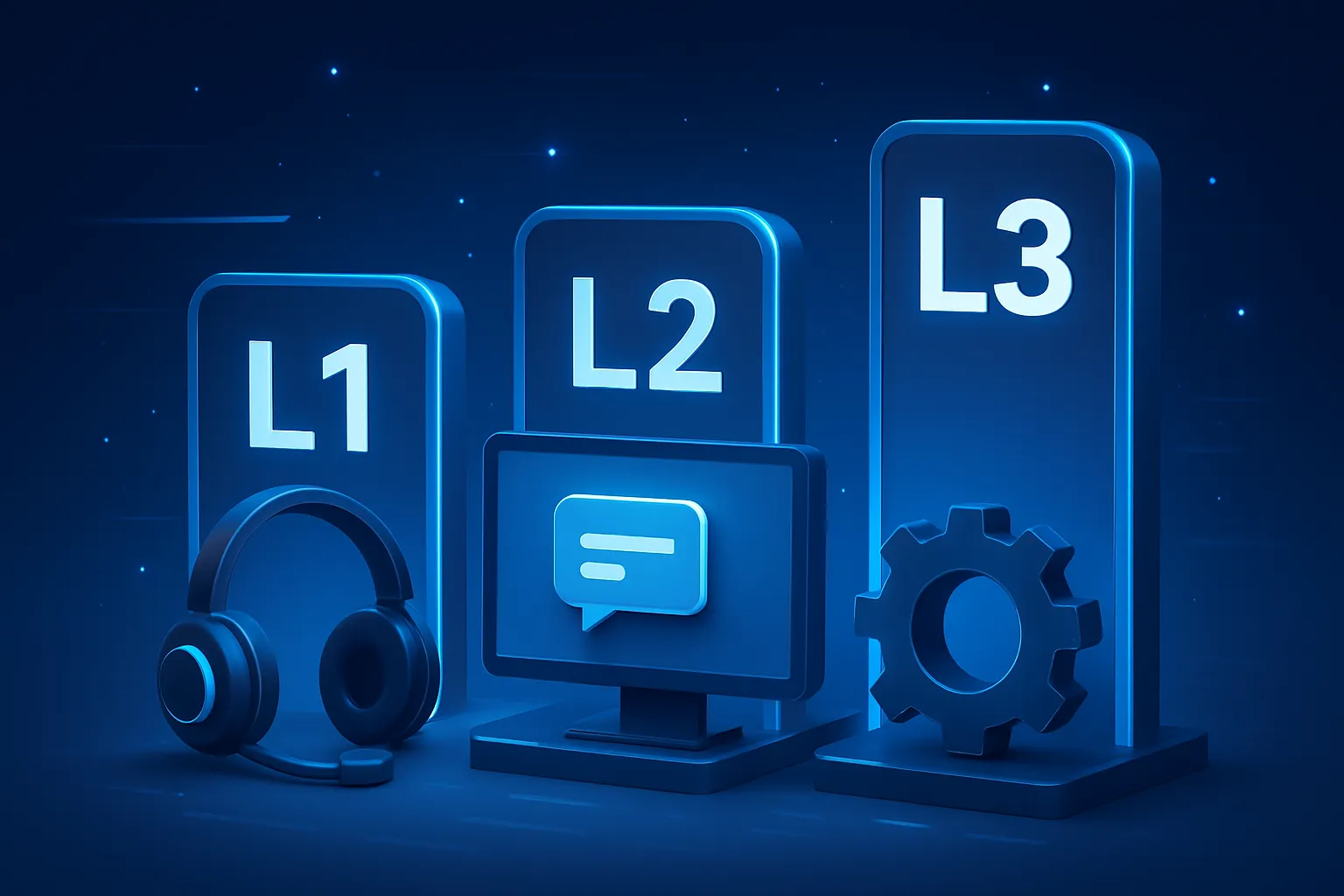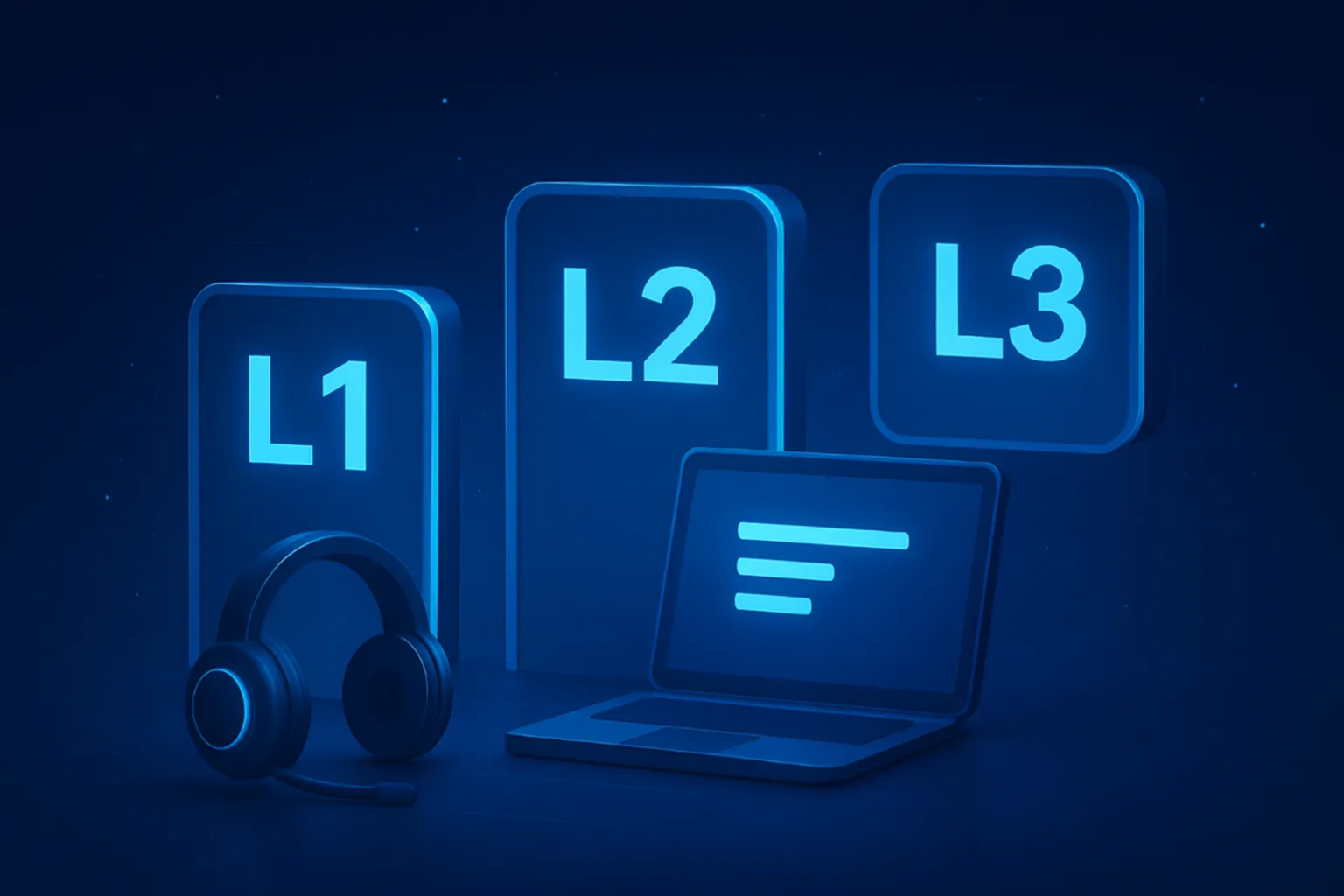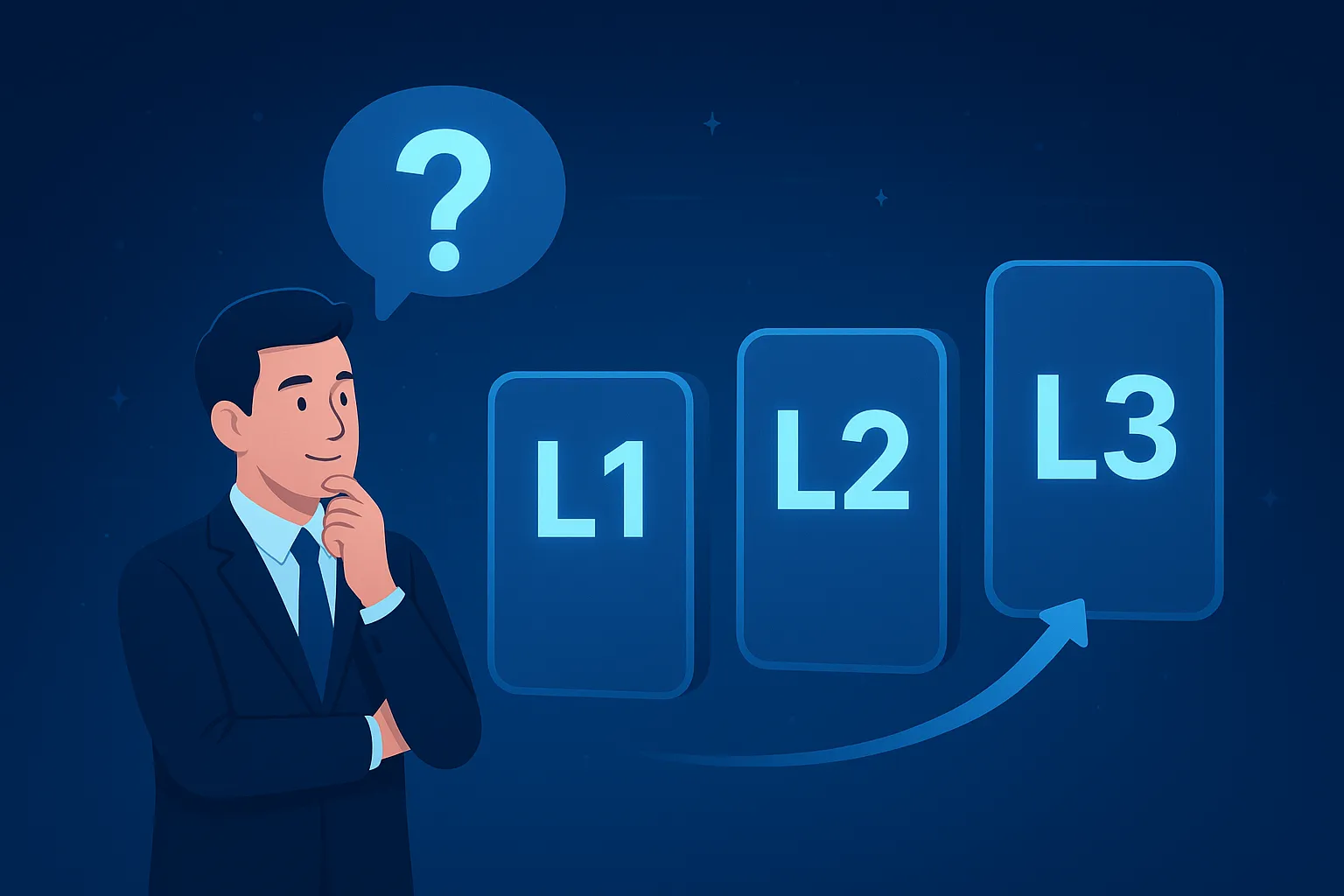October 2, 2025
October 2, 2025

Technology has become the backbone of modern businesses, supporting everything from daily operations to long-term strategic growth. Yet when technical issues arise, the difference between a quick resolution and prolonged downtime often depends on the type of IT support available. That’s where the structured system of IT support levels: L1, L2, and L3 comes in. Each level has its own responsibilities, expertise, and scope of problem-solving, ranging from basic troubleshooting at the helpdesk to complex system analysis and development.
By understanding how these levels differ and complement one another, businesses can make smarter decisions about the kind of support that best aligns with their size, goals, and IT challenges.
An IT support level is a structured way of categorizing technical assistance based on the complexity of issues and the expertise required to solve them. Instead of having one single team handle every problem, organizations divide IT support into levels: commonly known as Level 1 (L1), Level 2 (L2), and Level 3 (L3). Each level represents a tier of specialization, from handling simple, routine requests to resolving advanced, system-critical challenges.
The main purpose of this tiered model is efficiency. By filtering requests through different levels, businesses ensure that minor problems are resolved quickly without overloading specialists, while complex issues get the expert attention they deserve. For example, if an employee forgets a password, the issue can be resolved by an L1 helpdesk agent within minutes. But if a critical database crashes, the ticket may need to be escalated to L3 engineers who have in-depth knowledge of the system architecture.

This structured approach also brings clarity to both users and IT teams. End-users know who to reach out to for specific problems, while IT departments can allocate resources strategically, reducing costs and improving overall response times. In short, IT support levels are not just about categorizing work, they are about creating a seamless flow that balances speed, cost, and expertise in maintaining business continuity.
Level 1, often called the helpdesk, is the first point of contact for users when technical issues arise. L1 agents handle basic, routine problems such as password resets, account lockouts, software installation guidance, or simple troubleshooting steps. Their primary role is to collect information about the issue, provide immediate assistance where possible, and log tickets for further review if necessary.
Example: An employee cannot access their email because they forgot the password. An L1 technician verifies their identity and helps reset the password within minutes.
Key skills for L1 support include good communication, basic technical knowledge, and the ability to follow standard operating procedures.
Level 2 support involves more specialized technical knowledge. When L1 agents cannot resolve an issue, it is escalated to L2. These technicians dig deeper into system settings, server configurations, or network issues that require advanced troubleshooting. They may also handle hardware failures, software bugs, or security-related problems that go beyond the scope of L1.
Example: A user reports that their email client repeatedly crashes despite resetting the password and reinstalling the application. An L2 technician investigates system logs, identifies a compatibility issue, and applies a patch to resolve the problem.
L2 staff usually have more experience and certifications, enabling them to analyze recurring issues and propose long-term solutions.
Level 3 is the highest tier of IT support, typically staffed by subject matter experts, system architects, or developers. These professionals handle the most complex and critical problems, often involving the core infrastructure, custom applications, or security vulnerabilities.
L3 support is also responsible for creating fixes, developing updates, and collaborating with vendors or third-party providers to resolve issues that go beyond in-house capabilities. Unlike L1 and L2, which are reactive, L3 often plays a proactive role in system optimization and innovation.
Example: A company’s customer portal experiences a severe outage due to database corruption. L3 engineers step in to repair the database, recover lost data, and implement new safeguards to prevent future occurrences.
Together, L1, L2, and L3 create a tiered support system that balances quick response for simple issues with in-depth expertise for complex challenges. This layered approach ensures users get timely solutions without overloading high-level experts with basic requests.
Below are the most important differences that determine how tickets are triaged, who works on them, what tools they use, and how businesses measure success.

The first and most visible difference between support levels lies in what type of issues they handle and how much responsibility they take on.
This escalation model creates a filtering effect: simple issues stay at L1 for quick resolution, medium-complexity problems move to L2, and only critical cases reach L3. Without this structure, businesses would overload senior engineers with minor requests, wasting both time and money.
The required expertise and available resources also differ across levels.
What sets the levels apart is not just “who knows more”, but how knowledge is applied. L1 applies knowledge procedurally, L2 applies it diagnostically, and L3 applies it systemically by changing the system itself.
Response expectations and cost considerations further highlight the differences.
Costs rise in parallel. L1 support is relatively inexpensive since it requires more generalists. L2 staff are more costly because of their expertise and certifications. L3 is the most expensive resource, often involving senior engineers or external vendors. Escalating minor issues to L3 unnecessarily can drain budgets quickly.
That’s why a well-designed escalation flow is critical. Each level should hand over complete documentation, logs, error reports, and steps already attempted, so the next team doesn’t waste time repeating work. Done right, this process not only speeds up resolution but also ensures smooth collaboration across all levels.
The key differences between L1, L2, and L3 IT support can be summarized in four dimensions: scope of responsibility, depth of skills, response expectations, and cost implications.
Together, these levels form a layered support model that maximizes efficiency, minimizes downtime, and ensures resources are used wisely. For businesses, recognizing these differences is the first step toward building an IT support system that not only reacts to problems but also proactively strengthens operations.
Choosing the right IT support level or IT support service is not just about cost, it’s about aligning your technology needs with the right expertise to keep your business running smoothly. A small startup, for instance, might only need L1 support to handle day-to-day issues like software installations, email troubleshooting, or resetting passwords. This ensures that their lean team stays focused on growth without being bogged down by basic IT distractions.

On the other hand, a mid-sized company managing multiple systems and specialized applications will likely require a combination of L1 and L2 support. While L1 agents take care of routine tickets, L2 specialists can dive deeper into system errors, configuration problems, or recurring network issues. This balance saves time, improves efficiency, and prevents minor issues from snowballing into bigger disruptions.
For large enterprises or organizations running mission-critical operations, L3 support becomes indispensable. When you’re managing massive databases, complex integrations, or advanced cybersecurity measures, only senior engineers with in-depth technical knowledge can ensure stability and security. In these cases, L3 support acts as the backbone of digital resilience, protecting both revenue and reputation.
The truth is, many businesses don’t stick to just one leve, they blend them. A layered support strategy creates a safety net: simple issues are resolved quickly, while complex challenges are escalated seamlessly to experts. The key lies in assessing your business size, industry requirements, budget, and tolerance for downtime. By understanding where your pain points lie, you can design an IT support model that is both cost-effective and scalable for future growth.
A structured IT support system is more than just a way to organize technical teams, it’s a framework that drives efficiency, cost-effectiveness, and long-term stability for businesses. By clearly defining responsibilities across L1, L2, and L3 levels, companies can ensure that every issue is handled at the right depth without wasting resources or time.
One of the most obvious benefits is faster resolution times. Routine problems such as password resets or software glitches can be resolved quickly by L1 agents, allowing more experienced engineers to focus on advanced tasks. This not only reduces downtime but also enhances user satisfaction, as employees feel supported without delays.
Another advantage lies in cost optimization. Without a tiered system, businesses may find themselves relying on high-level engineers for even the simplest tasks, a clear waste of expertise and money. With structured support, resources are allocated more intelligently, ensuring that complex and high-value talent is only deployed where truly necessary.
A layered IT support system also strengthens scalability. As organizations grow, the variety and complexity of IT issues naturally increase. Having a clear escalation path from L1 to L3 allows companies to adapt seamlessly, maintaining high-quality service even as operations expand. For example, a retail chain opening multiple branches can rely on L1 teams for store-level support, while L2 and L3 experts handle network infrastructure and cybersecurity across the enterprise.
Finally, structured IT support fosters continuous improvement. When issues are categorized and escalated systematically, patterns can be analyzed to identify recurring problems and optimize systems proactively. This transforms IT support from a reactive service into a strategic function that prevents future disruptions.
In short, a structured IT support system provides more than problem-solving, it delivers speed, cost savings, scalability, and resilience, all of which are critical for maintaining a competitive edge in today’s digital-first business environment.
Conclusion
IT support levels like L1, L2, and L3 are more than just categories; they represent a structured pathway that ensures every technical challenge is met with the right expertise. From quick fixes handled by frontline helpdesks to complex problem-solving managed by seasoned engineers, this layered system brings order, efficiency, and resilience to the way businesses manage technology.
Choosing the right mix of support levels is not a one-size-fits-all decision, it’s about understanding your business needs, resources, and growth ambitions. A startup may thrive with L1 support, while larger enterprises demand the full depth of L1–L3 collaboration to safeguard mission-critical operations. What’s constant, however, is the value of structure: reduced downtime, optimized costs, and a proactive approach to technology management.